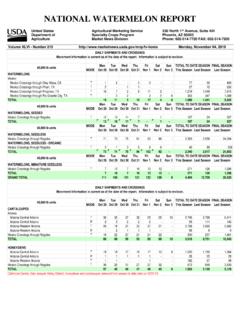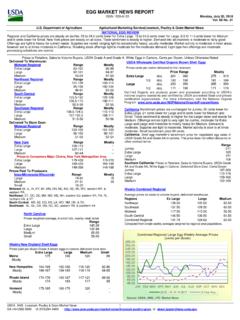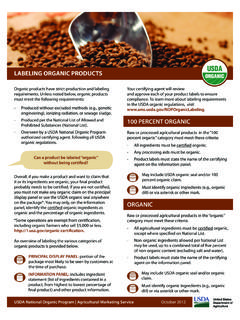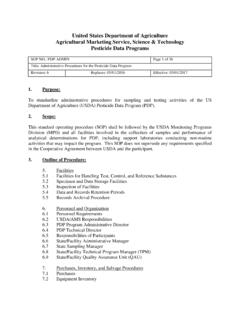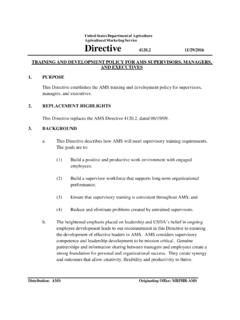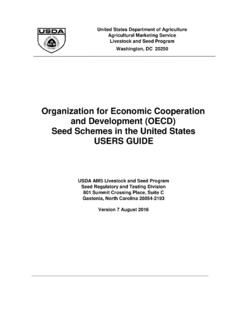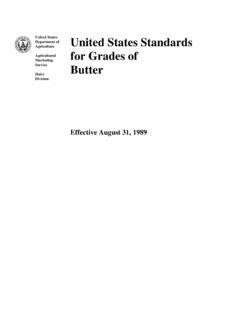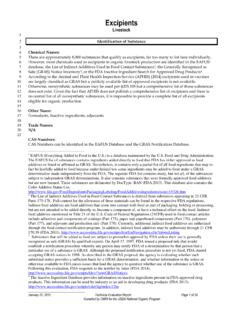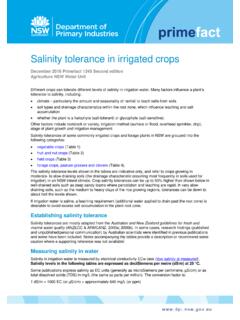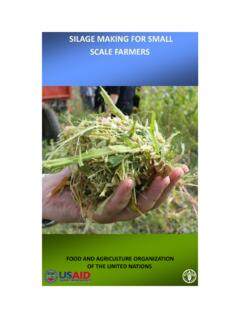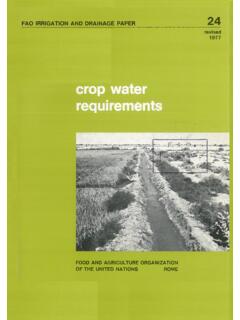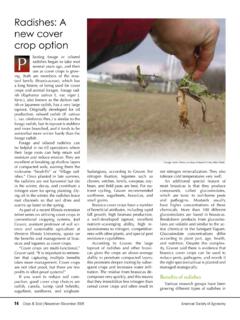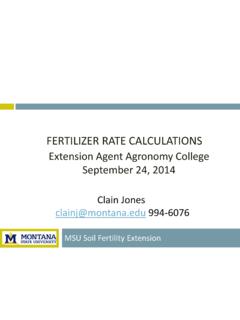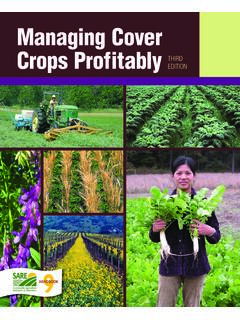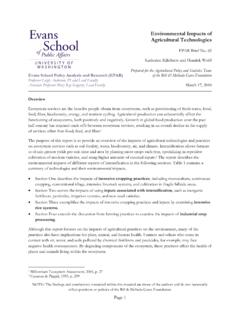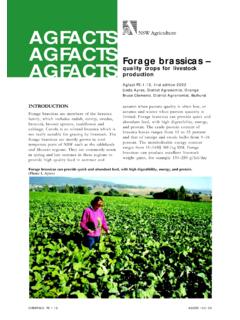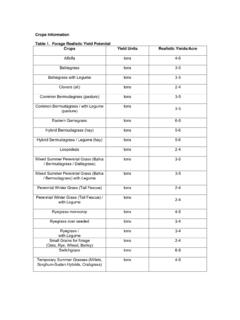Transcription of Introduction to Organic Practices
1 USDA is an equal opportunity employer and provider. USDA National Organic Program Agricultural Marketing Service September 2015 The USDA Organic regulations describe Organic agriculture as the application of a set of cultural, biological, and mechanical Practices that support the cycling of on-farm resources, promote ecological balance, and conserve biodiversity. These include maintaining or enhancing soil and water quality; conserving wetlands, woodlands, and wildlife; and avoiding use of synthetic fertilizers, sewage sludge, irradiation, and genetic engineering. Organic producers use natural processes and materials when developing farming systems these contribute to soil, crop and livestock nutrition, pest and weed management, attainment of production goals, and conservation of biological diversity.
2 This factsheet provides an overview of some common Practices that Organic producers and handlers use to ensure Organic integrity and operation sustainability. Soil Fertility: Crops more easily resist disease, survive drought, and tolerate insects when grown in good soil. Organic crop producers build soil quality by adding compost, animal manures, or green manures. As soil organisms break down these inputs, they convert nutrients into forms plants can absorb and create humus that sustains soil quality. Organic producers must not apply sewage sludge or biosolids to soil. Additionally, Organic crop producers use cover crops to protect the soil from wind and water erosion.
3 Soil-conserving Practices include the use of cover crops, mulches, conservation tillage, contour plowing, and strip cropping. Seeds and Planting Stock: Organic crop producers use Organic seeds and planting stocks to protect the integrity of their crops. Organic growers may use conventionally grown seeds when an equivalent Organic variety is not commercially available, but only if the seeds have not been genetically modified or treated with prohibited substances, such as fungicides. Crop Rotation: Organic crop producers practice crop rotation (rotating the crops they grow in a field or planting bed over time) to interrupt insect life cycles, suppress soil borne plant diseases, prevent soil erosion, build Organic matter, fix nitrogen, and increase farm biodiversity.
4 To effectively reduce insect and disease levels, farmers typically follow one crop with another from a different crop family, then wait a number of years before replanting the initial crop. While crop rotation is also practiced by many conventional farmers, Organic producers are required to implement the practice by the USDA Organic regulations. Managing Pests, Weeds, and Diseases: Pest management on Organic farms relies on the PAMS strategy: prevention, avoidance, monitoring and suppression. Prevention and avoidance are the first line of defense against pests, weeds, and diseases. If pest or weed suppression becomes necessary, producers often use mechanical and physical Practices , such as releasing predatory insects to reduce pest populations or laying down a thick layer of mulch to smother weeds.
5 As a last resort, producers may work with their Organic certifier to use an approved pesticide, such as naturally occurring microorganisms, insecticides naturally derived from plants, or one of a few approved synthetic substances. Maintaining Identity and Integrity of Organic Crops: Organic crop producers are responsible for preventing contact between Organic and conventionally-grown crops, as well as contact with prohibited pesticides or fertilizers. Split operations (farms that raise both Organic and conventional crops) must make sure that Organic crops don t contact prohibited substances through accidental sprays of conventional agrochemicals, spray drift, or residues on equipment from non- Organic fields.
6 Fields from which Organic United States Department of Agriculture Organic Crop Production Practices Introduction to Organic Practices USDA is an equal opportunity employer and provider. USDA National Organic Program Agricultural Marketing Service September 2015 crops are harvested must have defined boundaries and buffer zones, such as hedgerows or crops, separating them from conventional crops and roadways. Prohibited materials cannot be applied to land used for Organic cultivation for 36 months prior to harvest of Organic crops. Livestock Living Conditions and Facilities: Organic livestock producers provide living areas that encourage the health and natural behavior of their animals.
7 Organic Practices reflect concerns for animal welfare and a desire to balance productivity with both animal well-being and environmental quality. Organic livestock must have access to outdoor areas, shade, shelter, space for exercise, fresh air, clean drinking water, and direct sunlight. Livestock shelters should give animals protection from extreme temperatures, adequate air circulation and ventilation, and space to exercise. Grazing: Organic producers must give ruminant animals ( , cattle, sheep, and goats) access to pasture during the grazing season. Livestock may not be continuously confined. However, temporary confinement is allowed under specific circumstances, mostly regarding the health and safety of the animal.
8 By providing access to the outdoors, Organic livestock producers convert forage , legumes and grasses into meat, milk, wool, and other products. Grazing livestock also provide producers with manure, a very important source of fertility in Organic farming systems and an excellent means of recycling nutrients. Rotational grazing may improve forage quantity and quality, while preventing over-grazing. Animal Health: Organic animal health, like Organic crop health, relies on preventative Practices and systems. Good genetics are important, as Organic livestock producers should select breeds that are well adapted to their particular environment.
9 Balanced nutrition, exercise, and a low-stress environment also contribute to building strong immune systems in animals. Vaccination and other preventative measures are common; antibiotics and growth hormones are prohibited. Organic livestock producers work to manage exposure to disease and parasites through grazing management, proper sanitation, and preventing the Introduction of disease agents. Organic Feed: Organic livestock must eat certified Organic feed. Organic feed must be grown and processed by certified Organic operations. Similarly, any pastures, forages, and plant-based bedding (such as hay) accessible to livestock must be certified as organically grown and processed.
10 Certain additives, such as vitamins and minerals not produced organically, can be fed to Organic livestock in trace amounts, but others, including hormones used to promote growth, are strictly prohibited. Animal Origin: Organic livestock generally must be raised organically since the last third of gestation. Birds used for poultry or egg production, may come from any source, but must be raised organically beginning the second day of life. Organic Ingredients: Under USDA Organic regulations, Organic processors must use certified Organic ingredients (for a minimum of 95% of the product) and only approved non- Organic ingredient in products that are labeled Organic .
